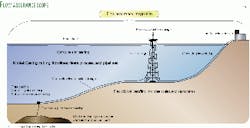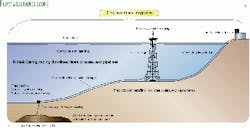Flow assurance challenges production from deeper water
One of the most critical challenges facing producers today is assuring oil and gas flow through complex and costly long subsea tiebacks.
Potential impediments can include formation and deposition of hydrates, paraffins, scales, and asphaltenes in wells, flowlines, or production facilities, as well as corrosive constituents in the flow stream, which may damage equipment and tubulars.
Producing wells on land and from fields in shallower water have similar problems, but in these cases, because of easier access, mechanical intervention and system changes are less costly. In deeper water, intervention costs increase and flow assurance becomes a significantly greater component in production economics, especially for developments in 4,000 ft or deeper water and connected to shallow-water host facilities that may be 50 miles away.
Deepwater environment
In deep water, many hydrocarbons are deposited in shallow structures, and therefore the wellhead flowing temperatures are typically not excessive, 110-140° F. To produce these accumulations, designers usually try to have the well fluid reach the processing facilities at temperatures above the wax appearance temperature and outside of the hydrate formation range. This can be difficult, because sea-bottom temperature in deep water is cold, often near or below 40° F., even in equatorial waters.
Cooling of flow streams during transportation can lead to precipitation of troublesome hydrates and other solids such as waxes and asphaltenes.
Problems caused by these factors are further exacerbated by reservoir depletion that alters the flow stream pressure and fluid characteristics over a producing field's life. A good design based on initial flow characteristics may cause problems later on. For instance, the point at which paraffin forms in the system will change as depletion occurs and reservoir pressure, flow rate, and flowing temperature decrease.
One challenge faced by designers is whether to install one or two flowlines to a subsea well or development. One flowline is less costly, but two will allow intervention such as circulation of pigs and fluid to remove impediments to flow.
Another consideration is reducing the number of flowlines by commingling streams from several wells or manifolds. This will reduce capital costs but may cause problems if the fluids in the streams are not compatible.
The schematic on p. 67 illustrates that the design scope for assuring flow from a subsea completion tied back to production facilities on a shallow-water platform starts at the reservoir and continues throughout the system.
For example in gas plants, excess methanol, an inhibitor for hydrates, can potentially cause propane specifications to be off and mol sieves to fail prematurely.
In refineries, methanol can become a problem in wastewater treatment.
Tackling the problem
Joint industry studies are one way the industry has addressed flow assurance problems. The DeepStar consortium of oil, vendor, and service companies has recently kicked off its fifth phase of studies.
Two studies will look at industry-wide information exchange for creating ways for safe, reliable production in water depths exceeding 5,000 ft. Paragon Engineering Services Inc., Houston, is the contractor for this work on behalf of DeepStar and in conjunction with the US Minerals Management Service. The studies address difficulties with long-distance, deepwater subsea tiebacks and deepwater intervention.
Paragon's studies aim to build on lessons learned so that flow assurance problems do not recur. Paragon says that, at present, both major oil companies and independents are experiencing flow assurance problems for which there are technical resolutions, and its goal is to get this technical information to all parties in the deepwater market.
It expects the information gathered will effectively improve design and management of flow assurance systems while also providing understanding of remediation capabilities.
Over the next 12 months, Paragon plans to interview both Gulf of Mexico and UK North Sea operators to develop case studies of 20 or more projects.
A recent flow assurance workshop identified the following new equipment development that would help assure flow:
- Installing reliable downhole instrumentation because data become more critical as water depth increases.
- Developing subsea pig launching systems to eliminate the need for two flowlines to deepwater subsea wells. One such system is being developed for Shell Exploration & Production Co.'s planned Gulf of Mexico Oregano and Serrano developments in 3,400 ft of water. The subsea pig launcher being designed will hold nine pigs initially and be capable of being reloaded.
- Providing well control umbilicals with control buoys near the wells to allow more dependability and flexibility. DeepStar is evaluating the associated risk with this concept.
- Gathering comparative data on top-tension risers and steel catenary risers that have been installed.
- Obtaining coiled pipe fatigue data for both coiled and reeled line pipe.
- Evaluating subsea separators that may impact flow assurance within the next few years.
- Installing subsea production pumping systems to help produce deepwater wells. Some of the first units are planned for installation off Brazil.
- Developing concepts for ultradeep pipeline intervention or remediation equipment. This equipment is in various stages of development and includes robotic taping machines and remotely operated vehicles.
- Expanding pipelay depth capability beyond the presently believed limit of a 24-in. pipe in about 10,500 ft of water. (Smaller-diameter pipe can be laid in greater water depths.)
Other issues for flow assurance include pipeline insulation materials, chemicals for wax deposition control, repair technology for pipe-in-pipe lines, electrically heated lines, and standard oil analysis.
Shell E&P plans to install pipe-in-pipe electrically heated flowlines in its Oregano and Serrano development. Also, a direct heating system has been installed in Statoil AS's Aasgard development, and Statoil has plans to install such a system on a 16-km flowline in Huldra field.
Obtaining fluid properties to determine problem fluid can also be difficult. For instance, to determine if asphaltenes will form downhole, some of the tests that may be needed include pressure-volume-temperature (PVT) analysis, high-temperature gas chromatography (HTGC), SARA (saturates, aromatics, resins, and asphaltenes) analysis, isothermal depressurization, isobaric depressurization, flocculation point apparatus (FPA) test, and asphaltene dispersant test (ADT).
Alcohols, glycols, and salts inhibit hydrate formation, and various empirical methods, charts, and computer programs can predict hydrate formation and inhibition.
New classes of compounds are being developed, such as kinetic inhibitors that slow the rate of hydrate formation and anti-agglomerators, which prevent the hydrates from agglomerating and forming plugs. These chemicals are now being developed and field-tested.
In most subsea applications, hydrate formation is controlled by injecting either a glycol, usually monoethylene glycol (MEG), or methanol. Glycol is normally recovered and recycled, whereas methanol is used both in once-through systems and in some cases partially recovered. Operating costs are significant, particularly for once-through methanol systems in wells producing at high gas or water rates.
Regeneration system installation depends on a trade-off between capital expenditures and operating expenses.
Both MEG and methanol can contribute to toxicity of produced water discharge overboard. For example, the limits for methanol concentration in water discharge to the North Sea is 1,000 ppm.
One study involving West Africa's Gulf of Guinea is evaluating materials suitable for the thermal insulation of pipelines and risers in 3,000 m of water. The study involves the operator TotalFinaElf SA, contractors Bouygues Offshore SA and Stolt Offshore AS, Bureau Veritas the certification authority, and the Ifremer and Institut Fran
The critical parameters for the study include the range of diameters, the potential laying methods, the in-service conditions, and overall heat-transfer coefficient. The project has been limited to nonjacketed insulation systems such as coated line pipe or molded shells around the line pipe.
About 15 materials, syntactic foams with different resins, elastomer, etc., are being tested.
Although questions remain, work is progressing that will allow deepwater tiebacks to be made farther from the host facility and in greater water depths.

